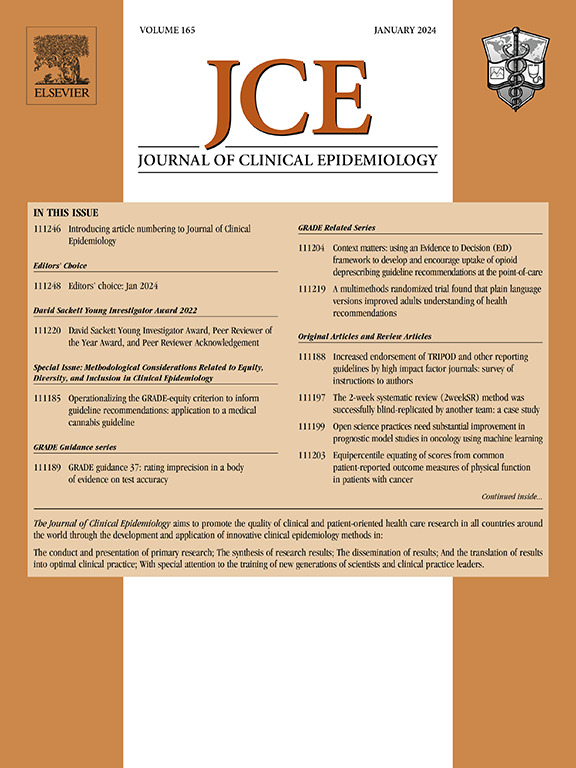Prediction models for outcomes in people with low back pain receiving conservative treatment: a systematic review
IF 7.3
2区 医学
Q1 HEALTH CARE SCIENCES & SERVICES
引用次数: 0
Abstract
Objectives
To identify, critically appraise and evaluate the performance measures of the available prediction models for outcomes in people with low back pain (LBP) receiving conservative treatment.
Study Design and Setting
In this systematic review, literature searches were conducted in Embase, Medline, and cumulative index of nursing and allied health literature from their inception until February 2024. Studies containing follow-up assessment (eg, prospective cohort studies, registry-based studies) investigating prediction models of outcomes (eg, pain intensity and disability) for people with LBP receiving conservative treatment were included. Two independent reviewers performed the study selection, the data extraction using the Checklist for critical Appraisal and data extraction for systematic Reviews of prediction Modelling Studies, and risk of bias assessment using the Prediction model Risk of Bias Assessment. Findings of individual studies were reported narratively taking into account the discrimination and calibration measures of the prediction models.
Results
Seventy-five studies developing or investigating the validity of 216 models were included in this review. Most prediction models investigated people receiving physiotherapy treatment and most models included sociodemographic variables, clinical features, and self-reported measures as predictors. The discriminatory capacity of the internal validity of the 27 prediction models for pain intensity varied greatly showing a c-statistic ranging from 0.48 to 0.94. Similarly, the discriminatory capacity for 31 models for disability had the same pattern showing a c-statistic ranging from 0.48 to 0.86. The calibration measures of the internal validity of the prediction models predicting pain intensity and disability showed to be adequate. Only one of 3 studies testing the external validity of models to predict pain intensity and disability and reported both discrimination and calibration measures, which showed to be inadequate. The prediction models predicting the secondary outcomes (eg, self-reported recovery, quality of life, return to work) showed varied performance measures for internal validity, and only 2 studies tested the external validity of models although they did not provide performance the performance measures.
Conclusion
Several prediction models have been developed for people with LBP receiving conservative treatment; however, most show inadequate discriminatory validity. A few studies externally validated the prediction models and future studies should focus on testing this before implementing in clinical practice.
腰背痛患者接受保守治疗后的疗效预测模型:系统综述。
目的:确定、严格评估和评价现有的腰背痛患者接受保守治疗后的疗效预测模型:识别、批判性评价和评估现有的腰背痛(LBP)患者接受保守治疗后的疗效预测模型的性能指标:在本系统性综述中,我们在 Embase、Medline 和 CINAHL 中检索了从开始到 2024 年 2 月的文献。包含随访评估的研究(如前瞻性队列研究、登记研究)均被纳入其中,这些研究调查了接受保守治疗的腰椎间盘突出症患者的预后模型(如疼痛强度和残疾程度)。两名独立审稿人进行了研究筛选,使用预测模型研究系统性综述的关键评估和数据提取核对表(CHARMS)进行了数据提取,并使用预测模型偏倚风险评估(PROBAST)进行了偏倚风险评估。考虑到预测模型的区分度和校准措施,对各项研究结果进行了叙述性报告:本次综述共纳入 75 项研究,这些研究开发或调查了 216 个模型的有效性。大多数预测模型都对接受物理治疗的人进行了调查,而且大多数模型都将社会人口变量、临床特征和自我报告措施作为预测因素。27 个疼痛强度预测模型的内部有效性的判别能力差异很大,c 统计量从 0.48 到 0.94 不等。同样,31 个残疾预测模型的判别能力也有相同的模式,c 统计量从 0.48 到 0.86 不等。对预测疼痛强度和残疾的预测模型的内部有效性的校准测量结果显示是充分的。三项研究中只有一项对预测疼痛强度和残疾程度的模型的外部有效性进行了测试,并报告了区分度和校准度,结果显示两者均不充分。预测次要结果(如自我报告的康复情况、生活质量、重返工作岗位等)的预测模型显示出不同的内部效度表现,只有两项研究对模型的外部效度进行了测试,尽管它们没有提供效度表现:结论:针对接受保守治疗的腰椎间盘突出症患者已开发出多个预测模型,但大多数模型的判别有效性不足。少数研究对预测模型进行了外部验证,未来的研究应在临床实践中实施前重点测试这一点。
本文章由计算机程序翻译,如有差异,请以英文原文为准。
求助全文
约1分钟内获得全文
求助全文
来源期刊

Journal of Clinical Epidemiology
医学-公共卫生、环境卫生与职业卫生
CiteScore
12.00
自引率
6.90%
发文量
320
审稿时长
44 days
期刊介绍:
The Journal of Clinical Epidemiology strives to enhance the quality of clinical and patient-oriented healthcare research by advancing and applying innovative methods in conducting, presenting, synthesizing, disseminating, and translating research results into optimal clinical practice. Special emphasis is placed on training new generations of scientists and clinical practice leaders.
 求助内容:
求助内容: 应助结果提醒方式:
应助结果提醒方式:


